One afternoon, in a trailer-house-cum-classroom outside Sunflower Elementary, a thick and commanding woman named Ms. Swenson gave a lesson to a small group of ten year olds. She spoke of Pompeii — an ancient city consumed so quickly by a volcanic eruption that bodies were frozen mid-stride. From that moment, I — a present student – began dreaming of one day going to gawk at all these bodies turned to stone, frozen snapshots of ancient life.
Well, either Ms. Swenson was wrong or my ten-year-old brain made a great leap from fact to fiction. Obviously burning hot lava can’t freeze anything. The real story?
About two thousand years ago, long before Italy was even Italy, an earthquake rattled the mid-shin of the boot. Over a decade later, the plebes and servants of affected ancient Roman cities were still recovering and reconstructing when Mt. Vesuvius — the neighborhood peak — blew its top. Hot volcano stuff consumed and enveloped Pompeii, Ercolano, and everything else. At Ercolano, lower temps preserved a wider quantity of material and greater quality. At Pompeii, much like the lava cast forest of Oregon where trees buried in lava burn slowly enough to leave a hollow, bodies were similarly vaporized, leaving a mold behind. Everything but stones were lost to the incredible heat.
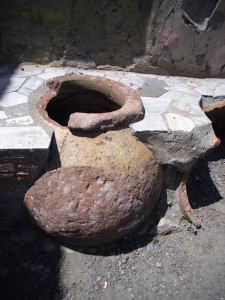
The equivalent of an early Roman tea/slurpee/coffee/soup dispenser. These containers survived in all the lunch shops.
It took excavation experts awhile to realize the holes they kept coming across at Pompeii were body molds, so really there are only a handful of casts that have been made. Bursts of excavation activity over the past thousand years have finally uncovered significant parts of the buried cities. Other travelers kept encouraging us to forgo the big name (Pompeii) for Ercolano where “everything is better preserved.” Our decision was made for us when we discovered our Torre del Greco (Naples) SERVAS* hosts actually lived on the border of Ercolano — five minutes from the ruins!
Our trip from the sheep farm to Naples/Ercolano consumed an entire day. First, at a gas-station in po-dunk nowhere, we hitched with two students to Lecce. Our mutal joy was discovering Vicenzo and Silvia actually knew our farm hosts! Then Michael, air traffic control maintenence man, gave us a lift in his company car to Brindisi. There — over our supermarket sidewalk lunch – we awkwardly witnessed a heavily drugged woman with urine-soaked pants having an altercation with store staff. Next, we were fortunate enough to be picked up by Vito — the nicest, most hospitable Italian ride we’ve ever had!
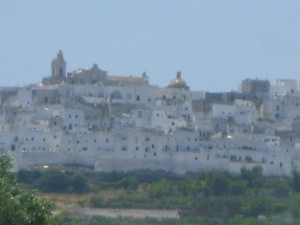
The through-the-windshield-zooming-down-the-highway shot doesn’t really do Ostuni justice – it’s gorgeous!.
He’s a steel broker who travels the region for work. After we ooohed-and-ahhed over a beautiful city on a distant hill, he pulled off the highway to give us an up-close view. Not just any village, Ostuni appeared as the Lord of the Rings city Minas Tirith. Vito also taught us the reason olive orchards are plowed (to get oxygen to the tree roots) and the many uses for lower quality olive oil (in the past as fuel for lamps, and now in soap, hand cremes, and industrial applications). We passed dozens of trully houses, the quirky, ancient dome homes of the region, and Vito pointed out the church where (jolly, old) St. Nicholas is buried! Along the way, our early morning milking started taking its toll. As sleepiness consumed us, we acknowledged it was time to get on a bus. Vito drove us to the station in his hometown (Bari), and then insisted on treating us to a beer while we waited for our bus to depart! What a guy! Proof that the world (and Italy) still has plenty of wonderful people in it!
Going from Bari to Naples means crossing from Italy’s east coast to its west. Thankfully, I woke halfway and got to see the gorgeous almost-mountains of south-central Italy — like the Black Hills, the Oregon Coastal Range, or the coastal hills of Northen California — amazing! Our SERVAS* hosts, Silvana and Giosue, along with their kids Virginia and Giulio, treated us to a lovely stay and an interesting cultural difference: doors at their house are always open! Even the teenage daughter whose room must be traversed for laundry and some family clothing access. Definitely not the possessive stuff I think of in the U.S.
Of course, being the birthplace of pizza, our first dinner couldn’t have been anything else. What I didn’t expect: a pizza EACH and then some! The following day of sightseeing included touring a Bourbon villa, a display of the amazing castles of Italy, descending into the Ercolano excavation hole, and — unfortunately — excessive amounts of dog shit and graffiti. The latter aside, spending the day in the shadow of Vesuvius surrounded by flowers and sea breezes was pretty rad. The evening totally rocked — Silvana, her father, and her brother all share a birthday month. At the party we met tons of Italians, learned spicy steps from the family dance instructor, and ate the. most. incredible. food. Impossibly beautiful bruschetta. The lightest, fluffiest, creamiest tiramisu. Killer mozzarella. I’m not even a mozzarella lover and I’m telling you Bufalo Mozzarella is the best thing you’ll ever taste. If I can make the stuff in the U.S., I’m going to be a millionaire.
Like always, our time was too short. The visit culminated in our first Italian train ride where, because of Asia’s lingering influence, we struggled through several cars trying to find our way out of first class. We only had to spot the number two on four carriage doors before it all clicked into place! ♣
Related photos on Facebook: bomb baked goods, gas station on the sidewalk, the infamous Mt. Vesuvius.
*I haven’t yet explained SERVAS. It’s much like Couchsurfing, only I don’t recommend it. The people are great, just like CS. The similarities stop there. SERVAS is full of an enormous amount of red tape and run by executive committees who are so hostile to change that the organization is sure to perish within the next decade or two. After arranging interviews, dealing with stamps and envelopes (!!), parting with well over $100, and sending dozens of unanswered emails, you finally get to the good stuff. I firmly advise you to skip straight to Couchsurfing and leave SERVAS in the dust where it belongs.

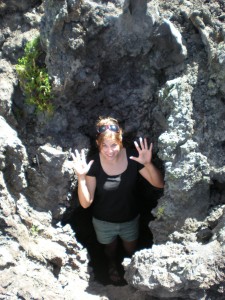
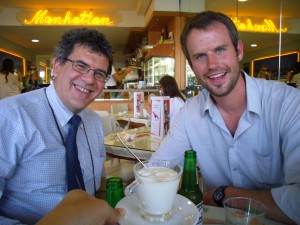
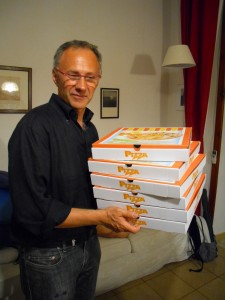




Twitter Facebook Google+ StumbleUpon Reddit Pinterest